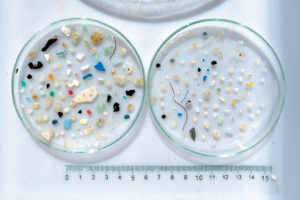 Background
Background
Over the last decade, plastic has become a more and more concerning source of pollution. In 2013 alone, almost 300 million pounds of plastic were produced worldwide (Lu et al 2017). Microplastics are defined as any plastic particle smaller than 5mm in diameter. Microplastics have been well documented as health concerns for marine life as more plastic accumulates in the ocean than any other place on earth. Additionally, microplastics have been found in a variety of household products including toothpaste and cosmetic products. We are just beginning to understand the extent microplastics have infiltrated our environment as well as our bodies, let alone the health risks they pose. One area of study deserving attention is the effect these plastics have on the microbiome of an organism. A microbiome is all of the bacteria, fungi, and viruses that live within or on a specific organism. Some of these microorganisms provide essential services to their host and maintaining a healthy microbiome has been tied to overall organismal health. Past studies have linked altered microbiomes to everything from obesity (Ridura et al 2013) to asthma (Stein et al 2016). Continue reading “From Microplastics to Microorganisms”
